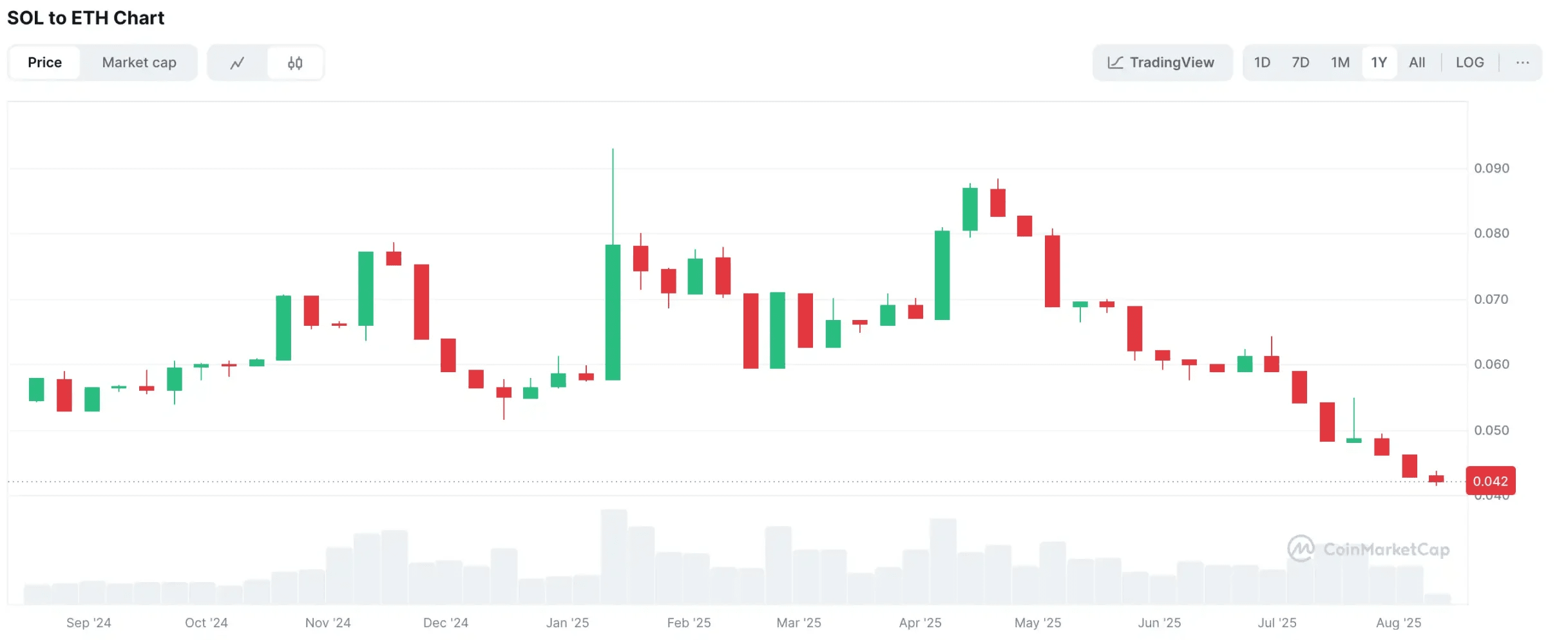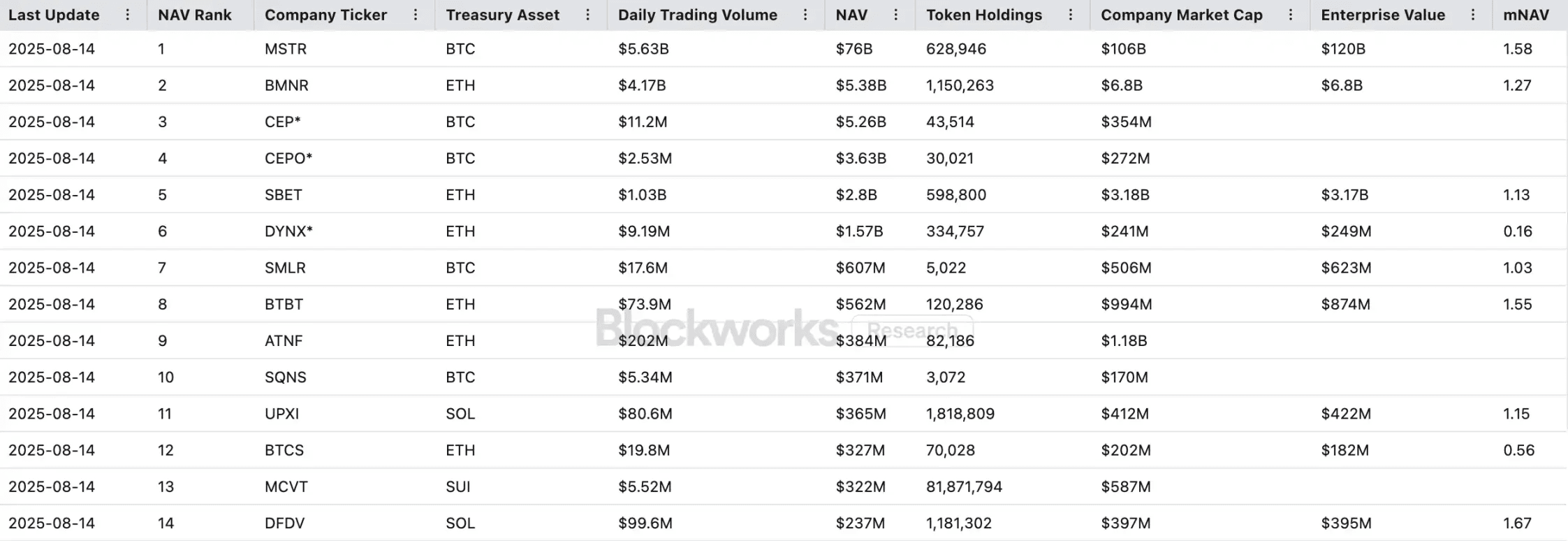On August 13, ETH strongly broke through $4,700, reaching a four-year high, while SOL seemed to struggle during the same period, lingering around $200. In 2024, Pump.fun ignited a meme frenzy across the entire Solana chain, and early in the year, Trump launched $TRUMP on it, causing SOL's price to surge to around $300, leading to a clamor for 'Solana to replace ETH.'
However, the actual market trend provided a calm response. Although ETH and SOL are both advancing treasury strategies in an attempt to accumulate 'bullets' for their ecosystems, their performances have diverged significantly— the SOL/ETH exchange rate plummeted from 0.09 at the beginning of the year to 0.042, with a weak pattern persisting throughout the year. The underlying reasons may reflect not only price volatility but also a comprehensive manifestation of differences in narrative heat, ecological structure, and capital expectations.

Treasury Strategy: The Dual Gap of Leadership and Capital Scale
On June 30, Wall Street's 'Counter-Trend Bull' Tom Lee parachuted into BitMine as chairman, while ETH was still hovering around $2,500. Just a month and a half later, ETH surged to $4,700, an increase of 88%. Lee has long been featured on major financial programs like CNBC and Bloomberg, and during the significant drop in U.S. stocks in 2022, he reversed market pessimism with precise 'bottom-fishing' remarks. Now, this market opinion leader with built-in traffic has become the best spokesperson for ETH treasury. Meanwhile, 'Cathie Wood' of ARK Invest also invested $182 million in BMNR stocks, further boosting confidence in the ETH camp.
Furthermore, although both ETH and SOL have their respective treasury strategy companies, their scales differ vastly. In terms of holdings, BTC and ETH treasury strategy companies occupy the top ten spots. The leading 'ETH Micro Strategy' BitMine Immersion (BMNR) recently plans to raise its financing size by $20 billion to increase its ETH holdings. Currently, it holds $5.3 billion in NAV (Net Asset Value), second only to MSTR. Such a level of capital means it has more 'bullets' during market fluctuations and a stronger ability to shape market trends. In contrast, the leading 'SOL Micro Strategy' has an NAV of only $365 million, ranking 11th, over ten times less than BMNR. With a lack of globally influential public spokespersons like Tom Lee and no equivalent capital firepower, SOL naturally appears to be struggling in this market cycle.

However, recent new moves from Solana are gradually compensating for this shortcoming. On August 12, 'SOL Micro Strategy' Upexi established a brand new advisory committee and appointed Arthur Hayes as the first member. Hayes is a co-founder of BitMEX and the pioneer of perpetual contracts, having served as a trader at Deutsche Bank and Citigroup, and now heads the digital asset investment fund Maelstrom. He possesses both traditional finance background and deep understanding of crypto market structure, enabling him to provide practical guidance for institutional financing and digital asset strategies.

Upexi's strategic goal is clear: to further expand its layout in SOL by leveraging Solana's scalability and efficiency. According to public documents, the company currently holds over 1.8 million SOL (valued at approximately $36.5 million) and will stake part of its holdings to earn a 7%–9% return, ensuring long-term holding while generating stable cash flow. Notably, the company will acquire locked SOL at a discount price, bringing benefits to shareholders. Upexi will recruit more members to join the advisory committee to provide expertise in the cryptocurrency and finance fields.
Meanwhile, other listed companies are also increasing their SOL holdings. For instance, DFDV further expanded its SOL holdings, with total holdings now exceeding 1 million; BTCM disclosed a new purchase of approximately 27,190 SOL and plans to convert some crypto assets into Solana. This institutional demand is expected to reduce the circulating chips in the secondary market, thereby forming support on the supply-demand level.
ETH ETF Leads, SOL ETF Awaits Breakthrough
The management scale of the ETH spot ETF has surpassed $22 billion, not only validating institutional recognition of ETH but also quickly establishing its absolute advantage in liquidity and market depth. With the continuous influx of institutional funds, BlackRock also submitted an ETH ETF staking application last month, which, if approved, will bring stable staking returns to holders and attract more long-term capital into the market.
In contrast, although REX-Osprey launched a Solana ETF (SSK) with a staking mechanism in July, market enthusiasm has been low, with net inflows of zero on most trading days and a cumulative inflow of only about $150 million since its listing. Moreover, it is not a standard spot ETF registered with the SEC, but rather holds SOL indirectly through other vehicles. This structure combines staking mechanisms with offshore ETF configurations, increasing the complexity of understanding and operation, causing some institutions to remain on the sidelines; the issuer REX's influence in branding and channels is also far behind Wall Street giants like BlackRock and Fidelity and lacks endorsements from heavyweight institutions.
Currently, the market's focus is shifting towards the SOL spot ETF applications expected to be approved in October from VanEck, Grayscale, and others. Once regulatory clearance is obtained, combined with capital driven by treasury strategies, if institutional investors begin seeking to diversify from BTC and ETH into other quality assets, the SOL ETF may bring new growth points to the Solana ecosystem.
The Fork in the Application Narrative
From the perspective of application narratives, ETH and Solana are currently on two entirely different tracks.
Ethereum is steadily building a compliant and sustainable on-chain financial infrastructure. The explosion of stablecoins has been described by Tom Lee as the 'ChatGPT moment' for the crypto industry. Currently, the global stablecoin market cap has surpassed $250 billion, with over half of the issuance and about 30% of Gas fees occurring on the Ethereum network, which not only further consolidates ETH's core position in the payment and clearing system but also provides a continuous cash flow for staking, DeFi yields, and on-chain infrastructure.
In addition, Robinhood has issued stock tokens on Ethereum Layer 2, and Coinbase is actively developing the Base chain ecosystem, all of which bring more application scenarios to ETH. Currently, Ethereum has almost become the only main chain capable of simultaneously meeting regulatory adaptability, ecological maturity, and scale effects. Once ETH occupies a key node in stablecoin payments and RWA clearing, its strategic position will be prioritized by financial institutions like a 'structural subscription right.'
On the Solana side, the main narrative is more focused on meme coins and the Launchpad battle, along with other 'old topics' of high volatility. Although there have been multiple attempts this year to enter the RWA field, supporting a series of tokens like $IBRL and Believe under the slogan 'Internet Capital Market,' all have ended in failure. However, a turning point arrived recently. On August 8, CMB International, a subsidiary of China Merchants Bank, partnered with Singapore's DigiFT and Solana's public chain service provider OnChain to tokenize a dollar money market fund recognized in Hong Kong and Singapore, issuing CMBMINT on-chain, setting a benchmark for cross-border RWA compliance cooperation. On that day, SOL's price broke through $200, and the market immediately viewed it as a potential new narrative starting point, hoping this new application scenario could open wider institutional capital channels for Solana.
Currently, although Solana still lags behind ETH in key indicators like market enthusiasm and exchange rate performance, its underlying competitiveness and potential space have not been diminished. As an 'American chain', it naturally possesses higher regulatory adaptability and capital recognition. Currently, ETH has gained institutional favor through treasury strategies, ETF trends, and RWA and stablecoin applications, but this also leaves SOL with opportunities for 'catch-up' and narrative switching.
Structurally, the expectation of the approval of spot ETFs will open new institutional capital entry points for SOL. Once products from giants like VanEck and Grayscale are approved, market liquidity and trading depth could experience a leap. Moreover, cross-border case studies of RWA have also proven that Solana's application capabilities on high-performance public chains are not limited to memes and Launchpads, and there remains significant room for improvement in penetration rates in areas such as DeFi, payments, and asset tokenization. The current pullback resembles more of a buildup rather than a farewell.
SOL ETH


